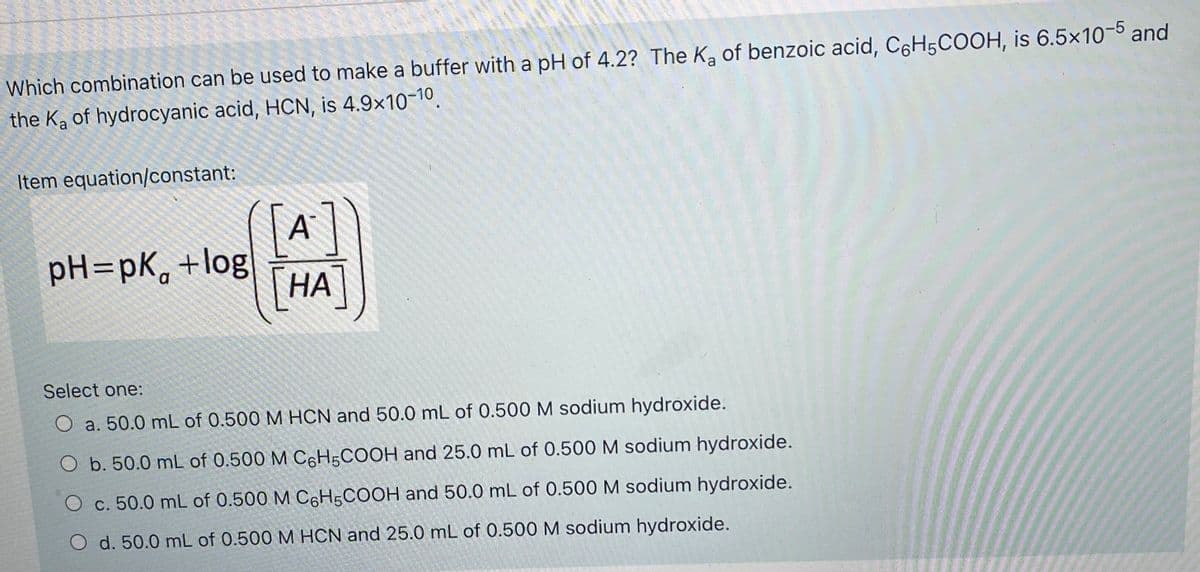Which combination can be used to make a buffer with a pH of 4.2? The Ka of benzoic acld, the Ka of hydrocyanic acid, HCN, is 4.9x10-10. Item equation/constant: A pH=pK. +log | HA Select one: O a. 50.0 mL of 0.500 M HCN and 50.0 mL of 0.500 M sodium hydroxide. O b. 50.0 mL of 0.500 M C6H;COOH and 25.0 mL of 0.500M sodium hydroxide. O c. 50.0 mL of 0.500 M OC&H5COOH and 50.0 mL of 0.500 M sodium hydroxide. O d. 50.0 mL of 0.500 M HCN and 25.0 mL of 0.500 M sodium hydroxide.
Which combination can be used to make a buffer with a pH of 4.2? The Ka of benzoic acld, the Ka of hydrocyanic acid, HCN, is 4.9x10-10. Item equation/constant: A pH=pK. +log | HA Select one: O a. 50.0 mL of 0.500 M HCN and 50.0 mL of 0.500 M sodium hydroxide. O b. 50.0 mL of 0.500 M C6H;COOH and 25.0 mL of 0.500M sodium hydroxide. O c. 50.0 mL of 0.500 M OC&H5COOH and 50.0 mL of 0.500 M sodium hydroxide. O d. 50.0 mL of 0.500 M HCN and 25.0 mL of 0.500 M sodium hydroxide.
Chemistry: Principles and Reactions
8th Edition
ISBN:9781305079373
Author:William L. Masterton, Cecile N. Hurley
Publisher:William L. Masterton, Cecile N. Hurley
Chapter14: Equilibria In Acid-base Solutions
Section: Chapter Questions
Problem 49QAP: Consider the titration of butyric acid (HBut) with sodium hydroxide. In an experiment, 50.00 mL of...
Related questions
Question

Transcribed Image Text:Which combination can be used to make a buffer with a pH of 4.2? The K, of benzoic acid, C6H5COOH, is 6.5×10-5 and
the Ka of hydrocyanic acid, HCN, is 4.9x10-10.
Item equation/constant:
A
pH=pK, +log
НА
Select one:
O a. 50.0 mL of 0.500 M HCN and 50.0 mL of 0.500 M sodium hydroxide.
O b. 50.0 mL of 0.500 M C6H;COOH and 25.0 mL of 0.500 M sodium hydroxide.
O c. 50.0 mL of 0.500 M C H5COOH and 50.0 mL of 0.500 M sodium hydroxide.
O d. 50.0 mL of 0.500 M HCN and 25.0 mL of 0.500 M sodium hydroxide.
Expert Solution
This question has been solved!
Explore an expertly crafted, step-by-step solution for a thorough understanding of key concepts.
This is a popular solution!
Trending now
This is a popular solution!
Step by step
Solved in 2 steps with 1 images

Knowledge Booster
Learn more about
Need a deep-dive on the concept behind this application? Look no further. Learn more about this topic, chemistry and related others by exploring similar questions and additional content below.Recommended textbooks for you

Chemistry: Principles and Reactions
Chemistry
ISBN:
9781305079373
Author:
William L. Masterton, Cecile N. Hurley
Publisher:
Cengage Learning

Chemistry: An Atoms First Approach
Chemistry
ISBN:
9781305079243
Author:
Steven S. Zumdahl, Susan A. Zumdahl
Publisher:
Cengage Learning


Chemistry: Principles and Reactions
Chemistry
ISBN:
9781305079373
Author:
William L. Masterton, Cecile N. Hurley
Publisher:
Cengage Learning

Chemistry: An Atoms First Approach
Chemistry
ISBN:
9781305079243
Author:
Steven S. Zumdahl, Susan A. Zumdahl
Publisher:
Cengage Learning


Chemistry
Chemistry
ISBN:
9781305957404
Author:
Steven S. Zumdahl, Susan A. Zumdahl, Donald J. DeCoste
Publisher:
Cengage Learning

General Chemistry - Standalone book (MindTap Cour…
Chemistry
ISBN:
9781305580343
Author:
Steven D. Gammon, Ebbing, Darrell Ebbing, Steven D., Darrell; Gammon, Darrell Ebbing; Steven D. Gammon, Darrell D.; Gammon, Ebbing; Steven D. Gammon; Darrell
Publisher:
Cengage Learning

Chemistry: Principles and Practice
Chemistry
ISBN:
9780534420123
Author:
Daniel L. Reger, Scott R. Goode, David W. Ball, Edward Mercer
Publisher:
Cengage Learning